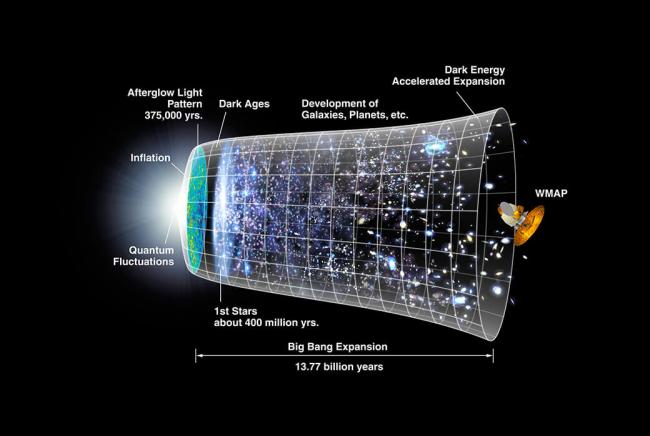
Introduction:
historical development of dark matter and dark energy concepts
All the atoms and light in the universe together make up less than five percent of the total contents of the cosmos. The rest is composed of dark matter and dark energy, which are invisible but dominate the structure and evolution of the universe. Dark matter is the mysterious, collisionless matter that holds galaxies together and dark energy is the even more mysterious, almost uniform component with negative isotropic pressure that produces cosmic acceleration.Dark matter makes up most of the mass of galaxies and galaxy clusters, and is responsible for the way galaxies are organized on grand scales. Dark energy, meanwhile, is the name we give the mysterious influence driving the accelerated expansion of the universe. What these substances are and how they work are some of the major challenges facing modern astronomers.
Together, these components capture around 96% of the present day cosmic energy budget. Dark energy is responsible for around 74% while dark matter captures almost a quarter, making it six times more abundant than visible matter.
Although, various dark energy theories exist, they have various shortcomings and currently, therefore, there exists no solid theory that can satisfactory describe the nature and effects of dark energy and dark matter.
Galactic dynamics such as the flatness of galactic rotation curves and the dynamics of galaxy clusters provided evidence for unseen matter that scientists called dark matter. Before 1998, the general assumption was that the universe’s expansionwas decelerating. Astronomers later discovered the universe was accelerating due to what they called dark energy. Constantly accumulating observational data show that dark energy and dark matter occupies roughly 74% and 423% of the energy density in the universe respectively. So far, dark matter and dark energy are inferred from their gravitational influence on the visible matter. Different theoretical approaches have been adopted to describe these components
This article aims to provide the reader with a basic understanding of Dark Energy and Dark Matter , the interaction between these mysterious components , and finally an overview of the future possibilities and opportunities in these fields .
observational evidence for dark matter :
Over the past decade, a consensus picture has emerged in which roughly a quarter of the universe consists of dark matter. A standard model of cosmology is emerging (often dubbed the Concordance Model), in which the universe consists of 4% ordinary baryonic matter, ∼ 23% dark matter, and ∼ 73% dark energy, with a tiny abundance of relic neutrinos. The baryonic content is well-known, both from element abundances produced in primordial nucleosynthesis roughly 100 seconds after the Big Bang, and from measurements of anisotropies in the cosmic microwave background (CMB). The evidence for the existence of dark matter is overwhelming, and comes from a wide variety of astrophysical measurements.The evidence that 95% of the mass of galaxies and clusters is made of some unknown component of Dark matter (DM) comes from (i) rotation curves (out totens of kpc), (ii) gravitational lensing (out to 200 kpc), and (iii) hot gas in clusters.
Rotation Curves :
In the 1970s, Ford and Rubin 1970 discovered that rotation curves of galaxies are flat. The velocities of objects (stars or gas) orbiting the centers of galaxies, rather than decreasing as a function of the distance from the galactic centers as had been expected, remain constant out to very large radii. Similar observations of flat rotation curves have now been found for all galaxies studied, including our Milky Way. The simplest explanation is that galaxies contain far more mass than can be explained by the bright stellar objects residing in galactic disks. This mass provides the force to speed up the orbits. To explain the data, galaxies must have enormous dark halos made of unknown dark matter. Indeed, more than 95% of the mass of galaxies consists of dark matter. This is illustrated in Fig. 1, where the velocity profile of galaxy NGC 6503 is displayed as a function of radial distance from the galactic center. The baryonic matter which accounts for the gas and disk cannot alone explain the galactic rotation curve. However, adding a dark matter halo allows a good fit to data.
The limitations of rotations curves are that one can only look out as far as there is light or neutral hydrogen (21 cm), namely to distances of tens of kpc. Thus one can see the beginnings of DM haloes, but cannot trace where most of the DM is. The lensing experiments discussed in the next section go beyond these limitations.
Lensing:
Einstein’s theory of General Relativity predicts that mass bends, or lenses, light. This effect can be used to gravitationally ascertain the existence of mass even when it emits no light. Lensing measurements confirm the existence of enormous quantities of dark matter both in galaxies and in clusters of galaxies. Observations are made of distant bright objects such as galaxies or quasars. As the result of intervening matter, the light from these distant objects is bent towards the regions of large mass. Hence there may be multiple images of the distant objects, or, if these images cannot be individually resolved, the background object may appear brighter. Some of these images may be distorted or sheared. The Sloan Digital Sky Survey used weak lensing (statistical studies of lensed galaxies) to conclude that galaxies, including the Milky Way, are even larger and more massive than previously thought, and require even more dark matter out to great distances (Adelman-McCarthy et al. 2005). Again, the predominance of dark matter in galaxies is observed.
A beautiful example of a strong lens is shown in Figure 2. The panel on the right shows a computer reconstruction of a foreground cluster inferred by lensing observations made by Tyson et al. using the Hubble Space Telescope. This extremely rich cluster contains many galaxies, indicated by the peaks in the figure. In addition to these galaxies, there is clearly a smooth component, which is the dark matter contained in clusters in between the galaxies.The key success of the lensing of DM to date is the evidence that DM is seen out to much larger distances than could be probed by rotation curves: the DM is seen in galaxies out to 200 kpc from the centers of galaxies, in agreement with N-body simulations. On even larger Mpc scales, there is evidence for DM in filaments (the cosmic web).
Hot Gas in Clusters:
Another piece of gravitational evidence for dark matter is the hot gas in clusters. Figure 3 illustrates the Coma Cluster. The left panel is in the optical, while the right panel is emission in the x-ray (observed by ROSAT)(Briel & Henry 1997). [Note that these two images are not on the same scale.] The X-ray image indicates the presence of hot gas. The existence of this gas in the cluster can only be explained by a large dark matter component that provides the potential well to hold on to the gas.
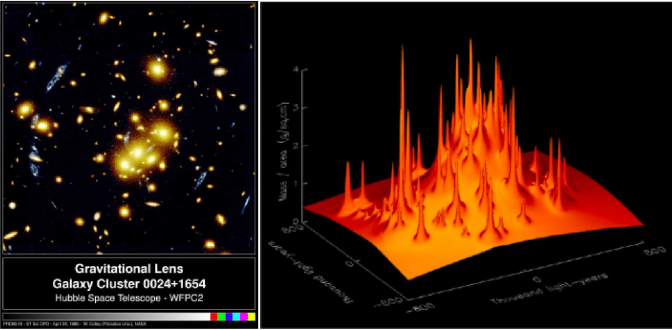
Left: The foreground cluster of galaxies gravitationally lenses the blue background galaxy into multiple images. Right: A computer reconstruction of the lens shows a smooth background component not accounted for by the mass of the luminous objects.
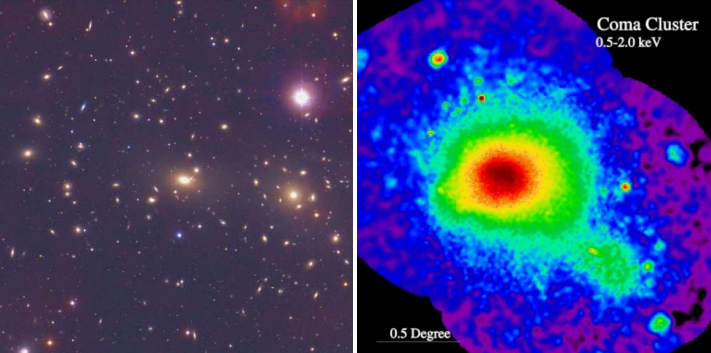
COMA Cluster: without dark matter, the hot gas would evaporate. Left panel: optical image. Right panel: X-ray image from ROSAT satellite.
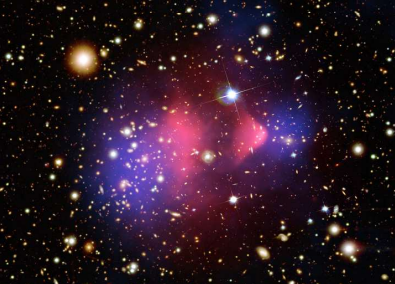
A collision of galactic clusters (the bullet cluster) shows baryonic matter (pink) as separate from dark matter (blue), whose distribution is deduced from gravitational lensing.
Bullet Cluster :
A recent image of the bullet cluster of galaxies (a cluster formed out of a collision of two smaller clusters) taken by the Chandra X-ray observatory shows in pink the baryonic matter; in blue is an image of the dark matter, deduced from gravitational lensing. In the process of the merging of the two smaller clusters, the dark matter has passed through the collision point, while the baryonic matter slowed due to friction and coalesced to a single region at the center of the new cluster. In modified gravity theories without dark matter, it is not likely that such a differentiation of these two components of the matter would take place. In summary, the evidence is overwhelming for the existence of an unknown component of DM that comprises 95% of the mass in galaxies and clusters.
detection methods :
Particle Accelerator Detection Method :
The most insightful way to detect dark matter would be to reproduce it inside of a particle accelerator. The Compact Muon Solenoid (CMS) and A Toroidal LHC Apparatus (ATLAS) are two such experiments run by CERN. These experiments have already successfully proved the existence of the Higgs particle, and there are many more signals that the collaborations are still analyzing. Since dark matter is weakly interacting, the creation of dark matter in a particle accelerator could only be discovered if an observed event was missing some momentum or energy. If the energy loss cannot be accounted for by any standard model particles, then it would be reasonable to conclude that it escaped as dark matter. Searches for dark matter using particle accelerators have heavily constrained theoretical models at ~4 GeV for spin-independent interactions and ~700 GeV spin-dependent interactions .
Absorption:
Dark matter could also be detected via absorption, which occurs when an inelastic collision between a dark matter particle and a target material results in a portion of the dark matter’s energy being absorbed by the material. In semiconductors, absorption can occur in two ways. If the dark matter mass is greater than 1 eV (approximately the band gap energy of a semiconductor), then the dark matter will excite an electron into
the conduction band. This will create an excess current in the target that can be directly measured. If the dark matter mass is less than 1 eV, then the dark matter will cause multiphonon excitations. Multiphonon excitations occur due to coupling between the crystal dipole moments and the phonons. The maximum energy of the lattice’s phonons is approximately the Debye temperature of the material. The sensitivity of this method has been shown to be approximately 0.01 – 1 eV, and it is possible that, with some technological improvements, semiconductor absorption targets could probe dark matter emitted from the sun .
Scattering:
For dark matter in the GeV mass range, it is possible to impact particles and scatter off of them. This method of detection is limited by the cross section of the target material used and by the excitation energy of that material. For light dark matter, elastic collisions can generate nuclear recoils inside of the target’s crystal lattice. The energy of the recoil is given by

where mN is the mass of the nucleus, q ~ vmDM is the momentum transferred, and v ≈ 10−3c is the DM velocity [5]. As the equation shows, dark matter with a larger mass will produce larger disruptions in the target material’s lattice structure, but larger target masses will reduce the amplitude of the disruption. Scattering is the most common method of detection due to its simplistic setup and higher potential interaction rates.
Scintillating Targets :
A more recent method of detection has developed around the scintillator technology. When certain materials are struck by a particle, they emit a photon. The strength of the photon is dependent on the mass of the scattering particle and the material chosen. By knowing the parameters of the target material, the scattering particle can be identified. By surrounding the target material with a photosensitive diode, the photons can be converted into an electrical signal that can be measured and analyzed. This method of detection can result in less background noise in the signal and can potentially have a higher sensitivity than traditional methods.
discovery of dark energy :
A key project for Hubble astronomers was to measure the amount of deceleration the universe is undergoing. The conventional wisdom was that gravity must be exerting a pull on the expansion of space after the big bang, like a ball rolling up an incline and gently slowing down under gravity.
The question persisted for decades as to whether there was enough mass, hence gravity, in the universe to halt the expansion of space. Astronomers, bolstered by the Hubble’s telescope’s ability to see faraway supernovas and precisely measure their distances, used the telescope to look ever deeper back in time to measure the expansion rate of the universe in its early years.
In 1998, two independent teams of astronomers presented evidence—to their surprise—that the universe’s expansion rate is actually accelerating rather than slowing down. The evidence was based primarily on the faintness of distant supernovas compared to their expected brightness in a universe decelerating under gravity. The acceleration appears to be propelled by the repulsive property of space—sort of an “anti-gravity” that pushes rather than pulls—called “dark energy.”
Previous Hubble observations of the most distant supernovas known revealed that the early universe was dominated by matter whose gravity was slowing down the universe’s expansion rate. The newer observations showed that the expansion rate of the cosmos began speeding up about five to six billion years ago. That is when astronomers believe that dark energy’s repulsive force overtook gravity’s attractive grip.
implications for the ultimate fate of the universe :
The evolution of the Universe is governed by the amount of dark matter and dark energy it contains, but the densities of dark matter and dark energy—their concentrations within a given volume of space—are affected very differently by cosmic expansion. We have a good idea of how much dark matter the universe holds, and although we don’t know precisely what it is, we do know it is affected by gravity. The key, then, to understanding the eventual fate of the Universe lies in understanding the other half of this dark equation: dark energy.
Currently cosmologists understand almost nothing about dark energy even though it appears to comprise about 70 percent of the mass-energy content of the Universe. They are desperately seeking to uncover its fundamental properties: its strength, its permanence, and any variation with direction. They must learn the properties of dark matter before they can determine its influence on the expanding Universe.
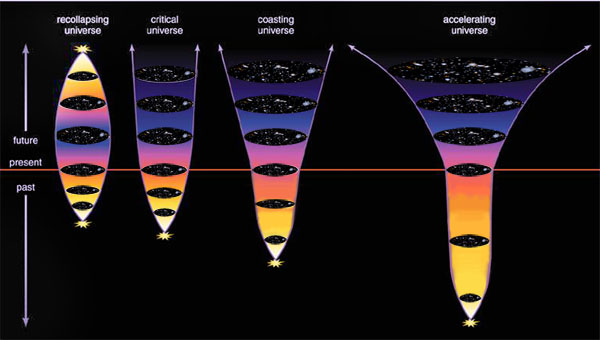
Various universe evolution scenarios. From left: A universe with too much density collapses in on itself, a critical density universe stays static, a universe with not enough density keeps expanding at a steady (coasting) rate. Then there’s what actually seems to be happening: the rate of expansion is speeding up.
This evolution in cosmic scale is schematically shown in the above figure for several cosmologies. In a universe with a high density of dark matter, the Hubble expansion that began with the Big Bang continues to decelerate due to the gravitation attraction of the dark matter filling the Universe, ending in a big crunch. In a universe with a lower critical density of dark matter, the expansion coasts. In a Universe with dark energy as well as dark matter, the initial deceleration is reversed at late times by the increasing dominance of dark energy.
If the hypothetical dark energy continues to dominate the Universe’s energy balance, then the current expansion of space will continue to accelerate, exponentially. Structures which are not already gravitationally bound will ultimately fly apart. The Earth and the Milky Way would remain undisturbed while the rest of the Universe appears to run away from us.
The nature of dark energy is currently a matter of speculation. Some believe that dark energy might be “vacuum energy,” represented by the “cosmological constant” (Λ, the Greek capital letter lambda) in general relativity, a constant uniform density of dark energy throughout all of space that is independent of time or the universe’s expansion. This notion was introduced by Einstein, and is consistent with our limited observations to date. Alternatively, dark energy might vary with cosmic time. Only new kinds of observations can settle the issue.
